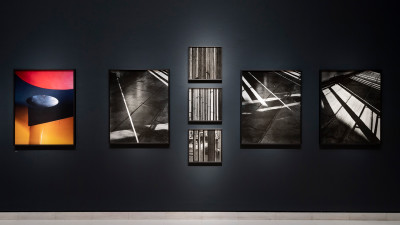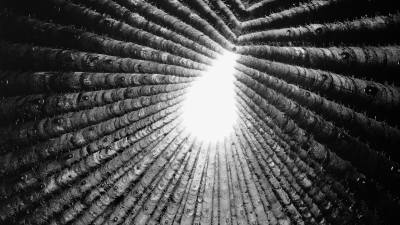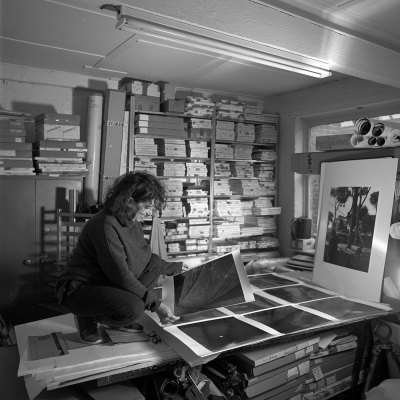“She has brought to architectural photography a mysterious dimension”: Daniel Libeskind on Hélène Binet
“She has brought to architectural photography a mysterious dimension”: Daniel Libeskind on Hélène Binet
By Daniel Libeskind
Published 16 December 2021
We’ve filled our galleries with Hélène Binet’s stunning photography. Here, the architect of the Jewish Museum in Berlin and many other wonders details what sets Binet’s timeless, elusive images apart.
-
From the Winter 2021 issue of RA Magazine, issued quarterly to Friends of the RA.
Daniel Libeskind Hon RA’s recent projects include the National Holocaust Memorial of Names, Amsterdam, and a forthcoming Maggie’s Centre at the Royal Free Hospital, London.
Since the 20th century, most people have experienced the skylines of great cities and the iconic buildings of our time through the lens of the photographer’s eye. The photograph has the power to replace the physical experience of a space.
The power of photography is one that can also undermine architecture by selecting certain angles in a particular light, editing out the aspects that are not photogenic. So as an architect, I have always had an ambivalent feeling about photography – its authenticity, authorship, and how it communicates the reality of buildings.
-

Hélène Binet, Daniel Libeskind/Studio Libeskind, Jewish Museum, Berlin, Germany, 1996.
Digital black-and-white silver-gelatin print. 127 x 100 cm. Courtesy ammann // projects. © Hélène Binet.
-
When I was a young student and I began to travel to see the masterpieces of architecture, I was struck by how different the buildings that I had studied in photographs were in real life. The spaces communicated something completely different to me when I experienced them first-hand. I felt I had only known an idealised preconception of these spaces that were conjured from the mind of the photographer. The photos captured two-dimensional graphic forms, rather than the architectural space itself.
Architecture is an art that exists simultaneously in space and time. It is paradoxical and almost impossible to conceive how it can be captured by sequential images; only a great photographer can do so. And of course today, we are bombarded with architectural images circulating endlessly on the internet, social media, film, TV. One could see that architecture can become ‘the real fake’; in other words, architectural space can be made into fiction through manipulation by other media.
-
Architecture is an art that exists simultaneously in space and time. It is paradoxical and almost impossible to conceive how it can be captured by sequential images; only a great photographer can do so.
Daniel Libeskind
-
When I first met Hélène Binet, I could see immediately that she approached architectural photography differently from those I had encountered before. It was the early 1980s and I was the head of the architecture school at Cranbrook Academy of Art in Michigan. Hélène’s future husband, Raoul Bunschoten, was my student. I vividly remember the first time we had a conversation because I immediately recognised that she was exceptional – she possessed an artistic spirit. I told her during our first meeting that to my knowledge, there was no other photographer approaching architecture in such an unconventional and creative way with no commercial aspect. Sensing her talent and the light in her eyes, I encouraged her to pursue photography as a career. She followed her vision with rigour and discipline.
In 1996, early in Hélène’s career, and mine as an architect, she flew to Berlin to photograph my first built project, the Jewish Museum in Berlin, when it was still under construction. She had no commission and no funding – she came because she saw something in the work I was doing. Over those days at the museum, Hélène produced a series of stunning and raw images that captured not only the architectural space, but the emotional impact of the cuts and the voids within the building’s structure that reflect the story of Jewish history in Germany. Her ability to follow the light was, in itself, a meditation on the meaning of built reality. Illustrated through the eye of the photograph, more is seen than can be seen with our own.
-

Hélène Binet, Daniel Libeskind/Studio Libeskind, Jewish Museum, Berlin, Germany, 1996.
Digital black-and-white silver-gelatin print. 127 x 100 cm. Courtesy ammann // projects. © Hélène Binet..
-
Hélène is an artist in her own right, but one who can capture the visions of other artists and communicate them authentically and without compromise. Indeed her subsequent career proved that architecture is more than the circulation of casual images in the Press or a haphazard blur in the marketplace of selling buildings.
She has brought to architectural photography a mysterious dimension that shows timelessness, depth of space, the expanse of detail, luminosity of texture, the weave of materials, the colour of dreams, and the enigma of presence. Like an alchemist of old, she has combined substances both physical and ineffable to produce the spiritual. Her vision is a crystallised multi-faceted macro- micro cosmic image that, in its two-dimensional form, vies in scale with its three-dimensional shadow.
Light Lines: The Architectural Photographs of Hélène Binet is in The Jillian and Arthur M. Sackler Wing of Galleries, Royal Academy of Arts, London, until 23 Jan. Supported by the Pictet Group
-
-

Enjoyed this article?
Become a Friend to receive RA Magazine
As well as free entry to all of our exhibitions, Friends of the RA enjoy one of Britain’s most respected art magazines, delivered directly to your door. Why not join the club?
-





